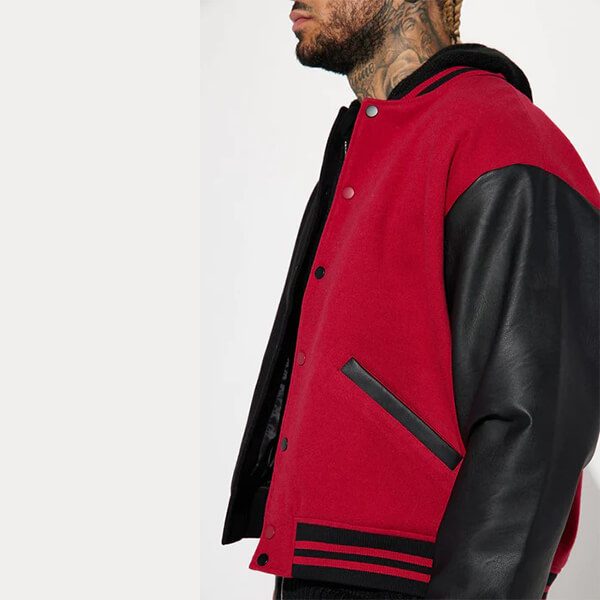How to Keep Sleeves on Your Letterman Jacket from Cracking?

Letterman jackets, known for their classic and bold appearance, are cherished pieces of clothing. Often a symbol of achievement, team pride, and personal style, these jackets are usually crafted from high-quality materials, with leather or faux leather sleeves that add durability and style. While the jacket’s body can usually withstand significant wear and tear, the sleeves often face more exposure to the elements and can easily show signs of aging if not well maintained. Regular sleeve maintenance is essential to preserve the look and longevity of a letterman jacket, ensuring it remains as timeless as the memories it represents.
Philadelphia Eagles NFL Varsity Letterman Jacket
1. Understanding the Materials Used in Letterman Jacket Sleeves
Letterman varsity jackets are iconic, often combining a sturdy body with stylish sleeves that give the jacket its unique appearance. The material used for these sleeves greatly impacts the jacket’s care and durability. Let’s explore the common types of materials used and how each affects maintenance.
1.1 The Different Types of Sleeves on Letterman Jackets
Leather
Leather sleeves offer a classic and high-end look, providing durability and sophistication. Known for its resistance to wear, leather is a popular choice due to its timeless appeal. However, leather requires regular conditioning and care to prevent drying, cracking, and fading over time.
Faux Leather
Faux leather, or synthetic leather, is a more affordable, cruelty-free alternative to genuine leather. It mimics leather’s look and feel but has different care requirements. Faux leather is generally easier to maintain but may be more prone to peeling if exposed to extreme conditions or poor care.
Wool
Wool is sometimes used for varsity jacket leather sleeves, though it’s less common. It adds warmth and softness to the jacket, giving it a vintage appeal. However, wool requires gentle handling, as it can be sensitive to moisture, pilling, and moth damage. Spot cleaning and proper storage are key to keeping wool sleeves looking fresh.
Toronto Raptors OVO x NFL Varsity Jacket
1.2 How Sleeve Material Impacts Care Requirements
Each sleeve material has unique characteristics that determine how it should be cared for:
- Leather requires frequent conditioning to prevent cracking and fading, as well as UV protection to guard against sun damage.
- Faux Leather benefits from occasional conditioning and should be kept away from extreme temperatures to avoid peeling.
- Wool requires gentle spot cleaning, anti-pilling measures, and protection from moths. Wool should not be exposed to harsh cleaning agents or moisture.
By understanding these care needs, jacket owners can tailor their maintenance routines to the specific materials, extending the life of their letterman jackets.
1.3 Identifying Your Jacket’s Sleeve Material
To properly care for a varsity jacket, it’s essential to identify the sleeve material. Look for tags inside the leather letterman jacket, as these often provide details about fabric composition. If tags are missing, a quick texture check can help—leather will feel firm and smooth, while faux leather often feels slightly softer and synthetic. Wool, on the other hand, is identifiable by its soft, fuzzy texture and natural warmth. Identifying the correct material ensures you use the appropriate care products and techniques.
H-D Limited Edition 120th Anniversary Varsity Jacket
2. Causes of Cracking in Letterman Jacket Sleeves
Over time, sleeve materials like leather and faux leather may start to crack, diminishing the jacket’s aesthetic appeal and durability. Understanding the common causes of this damage can help prevent premature wear and extend the jacket’s lifespan.
2.1 Common Causes of Cracking in Leather and Faux Leather Sleeves
Temperature Extremes
Exposure to extreme temperatures can cause both leather and faux leather to lose flexibility. Cold weather can make leather brittle, leading to cracks, while excessive heat can dry out both leather and faux leather, causing them to become stiff and prone to splitting.
Humidity and Moisture
Leather is a natural material that absorbs moisture, which can lead to cracking if the humidity fluctuates too often. On the other hand, faux leather can peel when exposed to moisture over time, especially if not properly sealed. High humidity can expand the material, and low humidity can dry it out, leading to a weakened surface.
UV Exposure
Sunlight exposure can fade and weaken leather and faux leather sleeves. UV rays dry out these materials, causing fading, brittleness, and eventually cracking. Using a UV-protectant spray can help mitigate this damage by adding a protective layer.
Blue Axel Arigato Illusion Letterman Jacket
2.2 How Poor Maintenance Leads to Cracking
Inadequate or improper maintenance is a primary cause of cracking in letterman jacket sleeves. Skipping regular conditioning for leather sleeves leads to dryness, as leather naturally loses oils over time. Similarly, failing to clean faux leather and leather sleeves means dirt and oils can accumulate, further weakening the material and increasing the likelihood of damage.
For wool, although it doesn’t crack, poor maintenance can result in pilling, stretching, or even moth damage if the material isn’t properly cared for. Regular maintenance is key to preventing all these issues.
2.3 The Role of Wear and Tear in Sleeve Damage
Everyday wear and tear naturally contributes to the deterioration of jacket sleeves. Constant bending and friction around elbows and wrists make these areas particularly susceptible to damage. For leather, this means regular conditioning and gentle handling can reduce friction damage, while for faux leather, avoiding high-friction activities can help minimize peeling.
While some degree of wear is unavoidable, proactive care can help manage these effects and extend the life of the jacket sleeves. Proper storage, cleaning, and conditioning routines will help ensure your varsity letterman jacket remains in great condition for years to come.
Guinness Varsity Leather Sleeves Unisex Jacket
3. Preventive Measures to Keep Sleeves from Cracking
To keep your letterman jacket looking pristine, preventive care is essential. Regular maintenance, proper storage, and the use of protective treatments can prevent cracking and wear in the sleeves, whether they are made from leather, faux leather, or wool.
3.1 Proper Storage Techniques
Avoiding Direct Sunlight
Prolonged exposure to sunlight can cause leather and faux leather to fade, dry out, and eventually crack. Always store your jacket in a cool, shaded area away from windows and direct sunlight.
Maintaining Ideal Humidity Levels
Both leather and wool are sensitive to humidity. Extremely low humidity can dry out leather, while high humidity encourages mold growth on wool. Aim to keep your jacket in a space with a stable humidity level, ideally between 40-50%. For homes in very dry or humid climates, consider a small humidifier or dehumidifier in the storage area to maintain balanced humidity.
Using Padded Hangers to Prevent Creasing
Using a padded hanger helps maintain the shape of your letterman jacket, especially around the shoulders, which can become misshapen on thin hangers. Padded hangers also prevent unsightly creases in the sleeves, reducing stress on the material and prolonging its life.
Damar Hamlin Travis Jesus Super Bowl Jacket
3.2 Routine Cleaning and Conditioning
Choosing the Right Cleaners for Leather vs. Faux Leather
Leather sleeves require gentle, leather-specific cleaners, while faux leather can be cleaned with mild soap and water. Avoid harsh chemicals on both materials, as they can strip away the natural oils and protective finishes.
How Often to Clean and Condition Sleeves
Routine cleaning should be done every few weeks, with more thorough conditioning every three to six months for leather sleeves. Faux leather can benefit from occasional conditioning, but be cautious with the amount to avoid buildup or peeling.
Applying Leather Conditioner for Optimal Results
A high-quality leather conditioner helps maintain flexibility and prevents cracking. For best results, apply conditioner evenly using a soft cloth, gently massaging it into the leather until it absorbs fully. Avoid over-applying, as excess conditioner can lead to a sticky surface.
3.3 Using Protective Treatments
Waterproofing Sprays
Waterproofing sprays create a barrier against moisture, essential for leather and faux leather sleeves. Apply a waterproofing spray designed for the specific material every few months, especially if you wear the jacket in wet weather.
UV-Resistant Coatings
UV-protectant sprays shield leather and faux leather from sun damage. Applying a UV-resistant spray reduces the risk of fading and drying, helping the material retain its color and elasticity over time.
Axel Arigato Illusion Varsity Jacket
4. Step-by-Step Guide to Conditioning Sleeves
Conditioning is a vital step in letterman jacket maintenance, especially for leather and faux leather sleeves. Proper conditioning helps maintain moisture, keeping sleeves soft and crack-free.
4.1 Cleaning the Sleeves Before Conditioning
Before conditioning, ensure the sleeves are free of dirt, dust, and oils. Here’s how to clean each material:
Recommended Cleaners for Different Materials
- Leather: Use a leather-safe cleaner or a mild soap solution (diluted in water) and apply with a damp cloth.
- Faux Leather: Use a gentle soap and water mixture for faux leather, avoiding harsh chemicals that can damage the surface.
- Wool: Use a wool-safe cleaner or spot-cleaning solution and blot gently.
Removing Dirt and Grime Without Damaging the Material
Wipe sleeves gently to avoid damaging the surface. Avoid soaking leather, as water can cause it to become stiff. Faux leather can handle a damp cloth but avoid excessive moisture. For wool, blotting with a gentle cleaner can lift stains without compromising the fibers.
4.2 Selecting the Right Conditioner for Leather or Faux Leather
Choose a conditioner specifically formulated for the material type. Leather conditioners are available in cream, oil, or spray form, each designed to moisturize leather. Faux leather conditioners are lighter and designed to keep the synthetic material flexible without causing peeling. Read the label carefully to ensure compatibility with your sleeve material.
Black Wool Letterman Jacket With Orange Leather Sleeves
4.3 Applying the Conditioner Correctly
Using a Soft Cloth vs. Sponge
For an even application, use a soft, lint-free cloth for leather and faux leather sleeves. Sponges may work but can sometimes apply too much product at once, making it harder to control the amount of conditioner on the surface.
How Much Conditioner to Use
Start with a small amount, as over-application can cause a sticky or uneven finish. Apply a thin, even layer, and add more only if the material appears to absorb it quickly.
Tips for Even Application
Apply the conditioner in gentle, circular motions. Work it into the material evenly to ensure no spots are missed, which can lead to uneven aging or cracking.
4.4 Allowing Time for Conditioner to Absorb
Once the conditioner is applied, let it sit for several hours to fully absorb. This helps the material retain moisture and prevents cracking. For best results, allow it to air dry in a cool, dry place, and avoid wearing the jacket until the conditioner is fully absorbed.
By following these preventive and maintenance steps, you can keep your letterman jacket leather sleeves looking pristine, preserving both their appearance and durability for years to come.
Navy Blue Wool Letterman Jacket With White Leather Sleeves
5. DIY vs. Professional Maintenance for Letterman Jacket Sleeves
Caring for your letterman jacket sleeves can be approached through DIY methods or by enlisting the help of professionals. Understanding the benefits and limitations of each approach will help you make an informed choice.
5.1 Pros and Cons of DIY Maintenance
Pros of DIY Maintenance
- Cost-Effective: DIY maintenance typically costs less than professional care, as most tools and products can be purchased and reused.
- Convenient: Performing maintenance at home allows for flexibility with time and frequency, making it easier to incorporate regular upkeep.
- Control Over Products: DIY care means you can choose the specific products you feel comfortable using, whether eco-friendly or specialty brands.
Cons of DIY Maintenance
- Potential for Mistakes: Without professional knowledge, there’s a risk of using the wrong products or techniques, which can damage the sleeves.
- Limited Solutions: DIY methods may not work for severe damage, such as deep cracks or peeling, which require specialized tools and expertise.
- Time-Consuming: DIY maintenance, particularly for leather, requires patience, as it involves cleaning, conditioning, and waiting for products to absorb properly.
5.2 When to Seek Professional Help
Recognizing Signs of Serious Wear or Cracking
While DIY solutions work well for minor issues, there are instances when professional help is necessary. Signs you should consult a professional include:
- Deep Cracks or Peeling: Severe cracks, especially in leather, may need specialized products to restore flexibility and appearance.
- Large Stains or Discoloration: Professionals have tools and chemicals that can treat stains or fading without damaging the fabric.
- Structural Damage: Tears, weakened seams, or significant fabric deterioration are often beyond the scope of DIY solutions.
5.3 Cost-Benefit Analysis of Professional Care
Professional maintenance offers a higher level of expertise but comes at a cost. Here’s a breakdown of factors to consider:
- Expense: While professional care is an investment, it can prolong the life of your jacket significantly, making it worthwhile for rare or cherished items.
- Quality: Professionals are trained to use products and techniques that minimize risk, which may result in a better outcome than DIY efforts.
- Frequency: If your jacket only needs seasonal or occasional upkeep, professional care can be a smart choice, particularly if you want it looking its best for special occasions.
Ultimately, the decision between DIY and professional care depends on the jacket’s condition, sentimental value, and how often you wear it.
Maroon Wool Letterman Jacket With White Leather Sleeves
6. Repairing Cracked Sleeves
Cracks in letterman jacket sleeves, whether leather or faux leather, can range from minor cosmetic issues to severe damage. Knowing how to assess and address these cracks can help prolong your jacket’s life.
6.1 Identifying the Severity of the Cracks
Start by assessing the cracks:
- Minor Cracks: These are surface-level issues that don’t penetrate deeply into the material. They may appear as small lines and can often be repaired at home.
- Major Cracks: Deeper, more pronounced cracks indicate that the material has dried significantly. These may require professional intervention or even replacement in extreme cases.
6.2 Minor Cracks: DIY Solutions
Leather Repair Kits
Leather repair kits are readily available and come with various tools, such as filler, adhesive, and applicators. These kits are ideal for minor cracks and can restore the appearance and feel of the material.
- Clean the Area: Wipe the cracked area with a soft cloth to remove dust or oils.
- Apply Filler: Use a small amount of filler from the kit to gently smooth over the cracks.
- Blend and Set: Smooth the filler to blend it with the surrounding area and allow it to dry as instructed.
Filling Minor Cracks with Leather Glue
Leather glue is another effective option for minor repairs. This glue is flexible, making it suitable for small cracks.
- Apply a Small Amount of Glue: Dab leather glue along the crack.
- Press Gently: Gently press the area together to bond the crack, then wipe away excess glue.
- Allow to Dry: Let the glue dry thoroughly to ensure a strong seal.
Gray Wool Letterman Jacket With Black Leather Sleeves
6.3 Major Cracks: When to Replace or Professionally Repair
For major cracks, particularly if the material is heavily dried or peeling, consider these options:
- Professional Repair: Leather repair specialists have advanced tools and products that can handle deep cracks and severe wear.
- Replacement: In cases of extensive damage, replacing the sleeve material may be the best option. This can be done professionally to match the original look of the jacket.
Professional repair may be the best choice if your jacket holds sentimental value, as a skilled technician can restore it without compromising the overall appearance.
6.4 How to Maintain Repaired Sleeves for Longevity
After repairing your jacket sleeves, ongoing maintenance is essential to prevent future cracking:
- Regular Conditioning: Use a leather conditioner or synthetic-safe product every few months to keep the material soft and flexible.
- Avoid Sun Exposure: Limit direct sunlight, as UV rays can weaken repaired areas and lead to more cracking.
- Handle with Care: Avoid overuse in harsh conditions, as friction and extreme weather can further damage repaired areas.
These preventive steps can help maintain your letterman jacket’s sleeves, ensuring that your DIY or professional repair efforts last as long as possible.
Conclusion
Maintaining the sleeves of your letterman jacket is essential to prolonging its life and keeping it looking its best. From understanding the materials used and the causes of cracking to implementing preventive measures and knowing when to seek professional help, proper care is key. Regular cleaning, conditioning, and protective treatments can prevent damage, while recognizing the signs of wear ensures timely maintenance. Whether you choose DIY solutions or opt for professional repairs, your efforts will pay off in the longevity and appearance of your cherished jacket. Remember to stay informed about best practices and act promptly to maintain the quality of your letterman jacket sleeves.
FAQs
- What Causes Leather Sleeves to Crack?
Leather sleeves crack due to a lack of moisture, environmental conditions like extreme temperatures, and improper care, including infrequent cleaning and conditioning.
- How Often Should I Condition My Letterman Jacket Sleeves?
Condition leather sleeves every 3 to 6 months, while faux leather sleeves can benefit from light conditioning every 6 months, depending on wear and exposure.
- Can I Use Regular Leather Cleaner on Faux Leather Sleeves?
No, regular leather cleaners can damage faux leather. Use a mild soap and water solution specifically formulated for synthetic materials.
- How Long Does Conditioning Last?
The effects of conditioning can last up to 6 months, but reapplication is necessary if the leather feels dry or stiff before that time.
- Are Waterproofing Sprays Safe for All Types of Sleeves?
Waterproofing sprays are generally safe for leather and faux leather, but ensure the product is specifically designed for the material to avoid damage.
- What Should I Do if My Jacket Gets Wet?
Blot excess water gently, allow the jacket to dry naturally away from heat sources, and apply conditioner once it is completely dry to maintain moisture.












